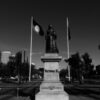Explore the history in Victoria Square and along King William Street and discover some of the stories behind the buildings of Adelaide.
Victoria Square, named after Princess Victoria (later Queen Victoria) in 1836, is the central and most significant of Adelaide’s squares.
3HCX+GX Adelaide SA, Australia
Victoria Square, named after Princess Victoria (later Queen Victoria) in 1836, is the central and most significant of Adelaide’s squares.
This impressive Aboriginal flag commemorates the site where it was first flown, on National Aborigines Day in 1971.
3HCX+GX Adelaide SA, Australia
The Aboriginal flag flies high over its birthplace, Tarntanyangga/Victoria Square, a symbol of Aboriginal pride, rights and identity.
The Three Rivers fountain commemorates the visit of Queen Elizabeth II and the Duke of Edinburgh to Adelaide in 1963.
220 Victoria Square, Adelaide SA 5000, Australia
The Three Rivers fountain in Victoria Square commemorates the Royal Visit in 1963
Unveiled in 1904, this statue commemorates the famous explorer John McDouall Stuart, the first European to cross Australia overland.
Unit 182/188 Victoria Square, Adelaide SA 5000, Australia
The statue of inland explorer John McDouall Stuart at the corner of Victoria Square and Flinders Street, Adelaide, commemorates his place in Australian history
Charles Cameron Kingston was Premier from 1893-1899, remembered for granting South Australian women the right to vote in 1894, the first in the world.
211 Victoria Square, Adelaide SA 5000, Australia
A remarkable and feisty South Australian attorney-general and premier, a father of federation and the first Australian Minster for Trade and Customs is commemorated by this statue
Built in 1881 for Government offices, this heritage-listed building is Adelaide's finest remaining Neo-Classical facade.
220 Victoria Square, Adelaide SA 5000, Australia
Built in 1881, this heritage-listed building on Victoria Square has long captured the public’s imagination with tales of secret tunnels.
Named after King William IV in 1837, King William Street is the main north-south thoroughfare of Adelaide.
Stop E1 King William St – East side, Adelaide SA 5000, Australia
Celebration, commemoration and protest happen amid the grand buildings that line Adelaide’s main thoroughfare
Completed in 1876, the General Post Office is renowned for its 49 metre tower, even taller than the Town Hall.
141 King William St, Adelaide SA 5000, Australia
The classically styled freestone Adelaide General Post Office housed both the post and telegraph offices which connected South Australia with the world.
Opened in 1866, the Adelaide Town Hall has been an important venue for concerts, public gatherings and meetings ever since.
15 Pirie St, Adelaide SA 5000, Australia
The classically inspired Adelaide Town Hall was opened in 1866 and accommodates council chambers and civic reception rooms. It remains a notable landmark in Adelaide today.
Opened in 1934 and heritage listed for its Romanesque style, the CML Building was the tallest building in Adelaide for 35 years.
45 King William St, Adelaide SA 5000, Australia
On the prominent corner of King William Street and Hindley Street, the Colonial Mutual Life (CML) Building is one of Adelaide’s most iconic structures.
Built in 1896, Beehive Corner with its Neo-Gothic facade has been a famous meeting spot since the early 20th century.
2-60 Rundle Mall, Adelaide SA 5000, Australia
Built in 1896, Beehive Corner with its Neo-Gothic facade has been a famous meeting spot since the early 20th century.





Comments